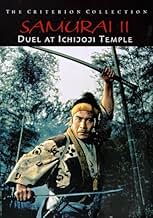CALIFICACIÓN DE IMDb
7.3/10
7.1 k
TU CALIFICACIÓN
Musashi Miyamoto regresa a Kioto tras años de ausencia. Tras una serie de combates contra la Escuela Yoshioka, reta a duelo a su maestro.Musashi Miyamoto regresa a Kioto tras años de ausencia. Tras una serie de combates contra la Escuela Yoshioka, reta a duelo a su maestro.Musashi Miyamoto regresa a Kioto tras años de ausencia. Tras una serie de combates contra la Escuela Yoshioka, reta a duelo a su maestro.
Argumento
¿Sabías que…?
- TriviaIn a scene in which Musashi is staying in a courtesan's compound to avoid his antagonists, he is seen painting in ink. In reality, Musashi was an artist and actually did create many works of art, such as one titled "Shrike in a barren tree", and they still exist to this day in museums throughout Japan.
- ErroresMany of the guys killed in swordplay go down with either no visible contact between their bodies and a katana, or appear to be hit in the arm or leg with a non-fatal slash that stills ends them, regardless.
- Citas
Musashi Miyamoto (Takezo): I renounce my love of women.
- ConexionesFeatured in Miyamoto Musashi kanketsuhen: kettô Ganryûjima (1956)
Opinión destacada
This comment about the "Samurai Trilogy" starts on the page for Miyamoto Musashi (Samurai I). My first viewing of the second episode was memorable because I got to take the train into town all by myself, and view it in a Tokyo theater. The first episode had just been shown on base, in a sort of cultural exchange, and my parents saw it and were pleasantly non-outraged-- I was a 9-year-old samurai-movie addict, and they believed enthusiasm beyond a certain intensity should be curbed. It was the same conflict as comic books some few years earlier. Technicolor was a big deal back then, especially in Japan, and it became the issue on which my viewing of "swordfighting movies" was decided-- the ones in color were historical films worth viewing, and even had something to teach. The black-and-white ones shown in Irumagawa and surrounding villages-- I had to sneak off to see. Ichijoji no Ketto (Duel at Ichijoji Temple) shows Miyamoto-san's achievements, while barring no holds on the issue of what they cost him. The romantic subplot continues, though its development in the western sense (toward union, wedded bliss) is thwarted at every turn. The issue is always a conflict between love and duty, and each deferment of gratification spells out a new step in the redefinition of the national character that is being mapped here. Again, some of the importance of all this is lost, even to modern Japanese audiences for whom the issues are long settled-- at the time, though, they were cliffhangers. A new character is introduced, Kojiro Sasaki who will emerge in part 3 as a rival for Musashi-- his equal except for certain features in their respective character. By the way, the score is excellent and haunting-- it extends like a symphony through all three parts, and has a leitmotif "hook" that will cause your ears to pick up in recognition, perhaps years from now, when you hear it again.
- foxfirebrand
- 28 jun 2009
- Enlace permanente
Selecciones populares
Inicia sesión para calificar y agrega a la lista de videos para obtener recomendaciones personalizadas
- How long is Samurai II: Duel at Ichijoji Temple?Con tecnología de Alexa
Detalles
- Fecha de lanzamiento
- País de origen
- Idioma
- También se conoce como
- Samurai II: Duel at Ichijoji Temple
- Locaciones de filmación
- Productora
- Ver más créditos de la compañía en IMDbPro
- Tiempo de ejecución1 hora 44 minutos
- Mezcla de sonido
- Relación de aspecto
- 1.37 : 1
Contribuir a esta página
Sugiere una edición o agrega el contenido que falta

Principales brechas de datos
By what name was Zoku Miyamoto Musashi: Ichijôji no kettô (1955) officially released in India in English?
Responda































